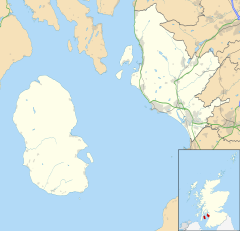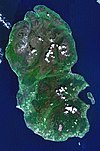Human settlement in Scotland
Catacol
| |
|---|---|
 The Twelve Apostles at Catacol Bay The Twelve Apostles at Catacol Bay | |
 | |
| OS grid reference | NR909496 |
| Civil parish | |
| Council area | |
| Lieutenancy area | |
| Country | Scotland |
| Sovereign state | United Kingdom |
| Post town | ISLE OF ARRAN |
| Postcode district | KA27 |
| Dialling code | 01770 |
| Police | Scotland |
| Fire | Scottish |
| Ambulance | Scottish |
| UK Parliament | |
| Scottish Parliament | |
| 55°41′42″N 5°19′34″W / 55.695°N 5.326°W / 55.695; -5.326 | |
Catacol (Scottish Gaelic: Catagal) is a small village on the Isle of Arran, in the council area of North Ayrshire, Scotland.
Geography
Catacol is located on the north west side of the island, just a few miles along the coastal road from Lochranza that continues on to Blackwaterfoot. It derives its name from Old Norse, referring to the 'gully of the cat', referring to the wildcats that may have roamed here. It is situated at the foot of Glen Catacol, a steep-sided valley down which the Abhainn Mor flows, where the river is crossed by a bridge just inland from the banks of shingle on the beach beside Catacol Bay.
Landmarks
Catacol's main feature is the row of cottages called the 'Twelve Apostles', which were completed around the middle of the 1860s. They were built to house those people cleared from the surrounding countryside, when much of the interior of the island was set aside for deer, the hunting of which had become fashionable among the landed gentry. The theory was these former farmers evicted from the land would turn to fishing, and with this in mind, each of the twelve cottages had a differently shaped first floor window. This would allow the woman of the house to signal by placing a candle in the window to her husband while he was out fishing on the Firth of Clyde. The husband would know who was being signalled by the shape of the window in which the candle was lit. In reality, most of the dispossessed crofters moved away to other parts of the island in protest against their eviction, and the houses remained empty for two years, during which time they were known as "hungry row". There is also a small jetty that is no longer used, an old anchor embedded into the grass and an old boat winch.
The village formerly housed a hotel, the Catacol Bay Hotel, know by locals as 'the cat', permanently closed in September 2018 due to the owner retiring. The surrounding area has grassy hills, moorland and patches of woodland in the steep-sided gullies. The Isle of Arran is the only place in which the Catacol whitebeam (Sorbus pseudomeinichii) is to be found. This is an extremely rare tree endemic to the area, thought to be a hybrid of the native rowan (Sorbus aucuparia) and the cut-leaved whitebeam (Sorbus pseudofennica), of which there may be only one or two surviving specimens.
Other notable landmarks include an old anchor embedded into the grassy bank by the beach, and a small jetty.
References
- ^ Walk the Arran Coastal Way. Walkguides. p. 7.
- Philip's (1994). Atlas of the World. Reed International. p. 18. ISBN 0-540-05831-9.
- ^ Basford, Joan, ed. (2002). History of the Villages of the Isle of Arran. Scottish Women's Rural Institute. p. 29.
...from old newspapers found plastered on to the roof timbers of one of the houses it is clear that they were not completed until the middle of the 1860s
- Beech, E.; Rich, T.C.G.; Rivers, M.C. (2017). "Sorbus pseudomeinichii". IUCN Red List of Threatened Species. 2017: e.T79749367A79749371. doi:10.2305/IUCN.UK.2017-2.RLTS.T79749367A79749371.en. Retrieved 24 October 2020.
External links
| Isle of Arran | ||
|---|---|---|
| Main villages |  | |
| Smaller villages and settlements | ||
| Mountains and hills | ||
| History |
| |
| Environment | ||
| Economy | ||
| Surrounding islands | ||